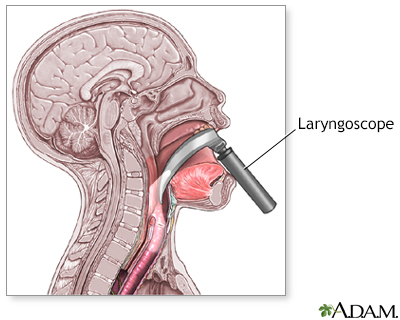Pregnancy SmartSiteTM
Laryngopharyngoscopy; Indirect laryngoscopy; Flexible laryngoscopy; Mirror laryngoscopy; Direct laryngoscopy; Fiberoptic laryngoscopy; Laryngoscopy using strobe (laryngeal stroboscopy) DefinitionLaryngoscopy is an exam of the back of your throat, including your voice box (larynx). Your voice box contains your vocal cords and allows you to speak. How the Test is PerformedLaryngoscopy may be done in different ways:
How to Prepare for the TestPreparation will depend on the type of laryngoscopy you will have. If the exam will be done under general anesthesia, you may be told not to drink or eat anything for several hours before the test. How the Test will FeelHow the test will feel depends on which type of laryngoscopy is done. Indirect laryngoscopy using a mirror or stroboscopy can cause gagging. For this reason, it is not often used in children under age 6 to 7 or those who gag easily. Fiberoptic laryngoscopy can be done in children. It may cause a feeling of pressure and a feeling like you are going to sneeze. Why the Test is PerformedThis test can help your provider diagnose many conditions involving the throat and voice box. Your provider may recommend this test if you have:
A direct laryngoscopy may also be used to:
Normal ResultsA normal result means the throat, voice box, and vocal cords appear normal. What Abnormal Results MeanAbnormal results may be due to:
RisksLaryngoscopy is a safe procedure. Risks depend on the specific procedure, but may include:
ConsiderationsIndirect mirror laryngoscopy should NOT be done:
ReferencesArmstrong WB, Vokes DE, Tjoa T, Verma SP. Malignant tumors of the larynx. In: Flint PW, Francis HW, Haughey BH, et al, eds. Cummings Otolaryngology: Head and Neck Surgery. 7th ed. Philadelphia, PA: Elsevier; 2021:chap 105. Mark LJ, Hillel AT, Lester L, Akst SA, Cover R, Herzer K. General considerations of anesthesia and management of the difficult airway. In: Flint PW, Francis HW, Haughey BH, et al, eds. Cummings Otolaryngology: Head and Neck Surgery. 7th ed. Philadelphia, PA: Elsevier; 2021:chap 5. Sarber KM, Lam DJ, Ishman SL. Sleep apnea and sleep disorders. In: Flint PW, Francis HW, Haughey BH, et al, eds. Cummings Otolaryngology: Head and Neck Surgery. 7th ed. Philadelphia, PA: Elsevier; 2021:chap 15 Sidell DR, Messner AH. Evaluation and management of the pediatric airway. In: Flint PW, Francis HW, Haughey BH, et al, eds. Cummings Otolaryngology: Head and Neck Surgery. 7th ed. Philadelphia, PA: Elsevier; 2021:chap 206. Syme NP, Hoffman HT, Anderson C, Pagedar NA. Management of early glottic cancer. In: Flint PW, Francis HW, Haughey BH, et al, eds. Cummings Otolaryngology: Head and Neck Surgery. 7th ed. Philadelphia, PA: Elsevier; 2021:chap 106. | |
| |
Review Date: 9/10/2023 Reviewed By: Josef Shargorodsky, MD, MPH, Johns Hopkins University School of Medicine, Baltimore, MD. Also reviewed by David C. Dugdale, MD, Medical Director, Brenda Conaway, Editorial Director, and the A.D.A.M. Editorial team. The information provided herein should not be used during any medical emergency or for the diagnosis or treatment of any medical condition. A licensed medical professional should be consulted for diagnosis and treatment of any and all medical conditions. Links to other sites are provided for information only -- they do not constitute endorsements of those other sites. No warranty of any kind, either expressed or implied, is made as to the accuracy, reliability, timeliness, or correctness of any translations made by a third-party service of the information provided herein into any other language. © 1997- A.D.A.M., a business unit of Ebix, Inc. Any duplication or distribution of the information contained herein is strictly prohibited. | |

 Voice box
Voice box Laryngoscope
Laryngoscope
